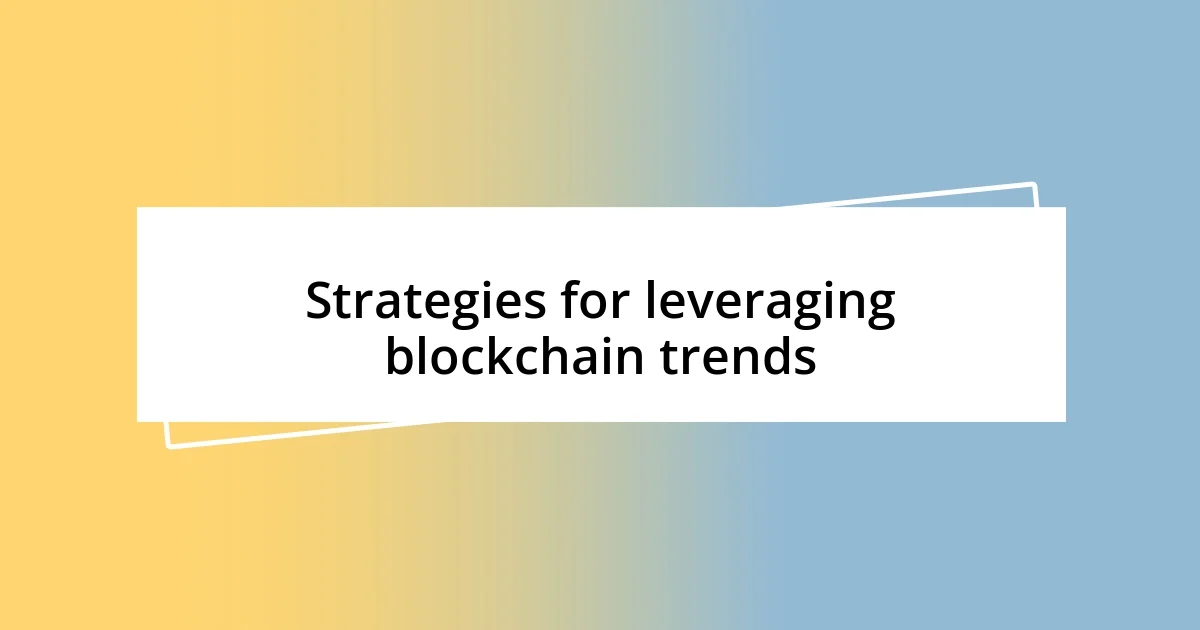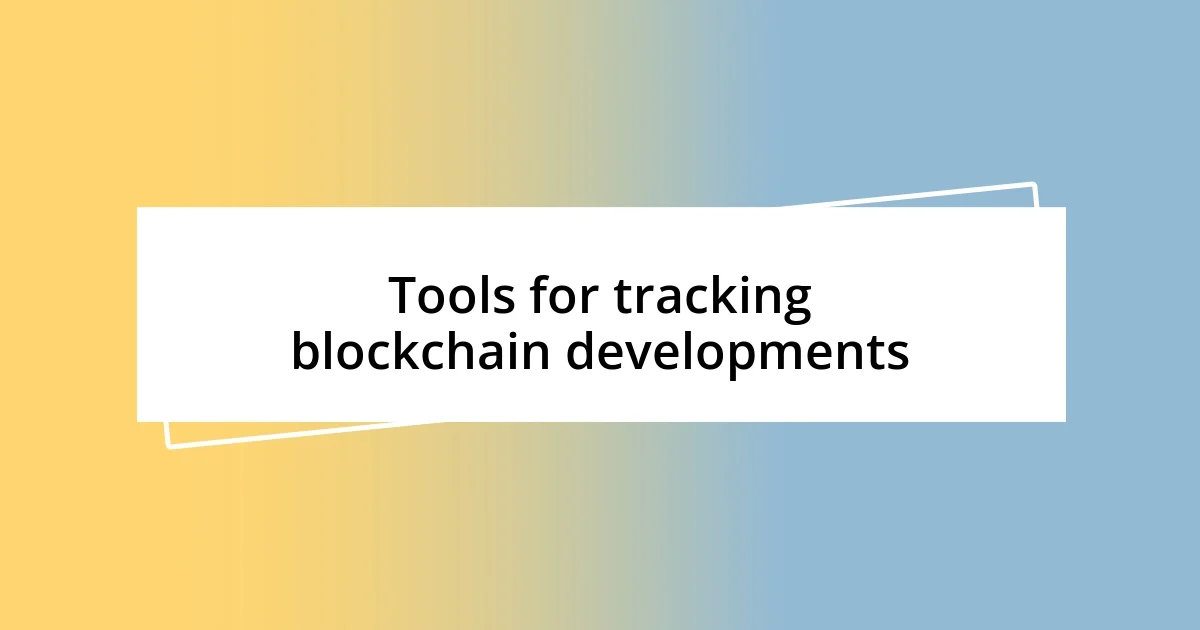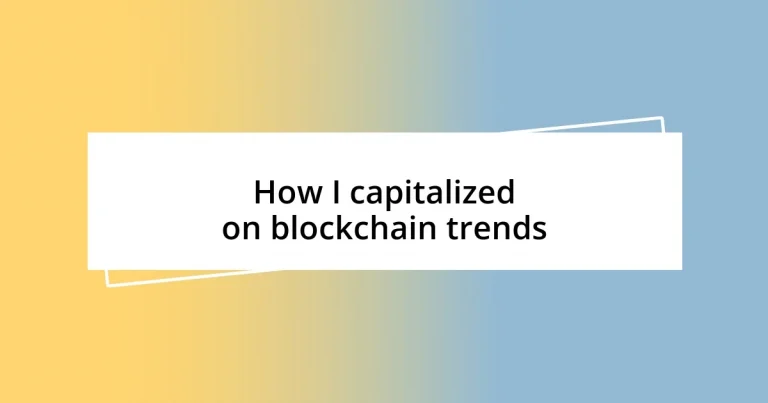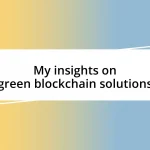Key takeaways:
- Blockchain technology enables peer-to-peer transactions, enhancing trust and transparency across sectors like supply chain and healthcare.
- Staying updated on emerging trends through networking, continuous learning, and community engagement is crucial for leveraging blockchain effectively.
- Future predictions for blockchain include the rise of decentralized finance (DeFi), the sustained relevance of non-fungible tokens (NFTs), and integration with artificial intelligence (AI) for improved transparency and data reliability.

Understanding blockchain technology’s impact
Blockchain technology has reshaped how we think about trust and transactions. I still remember the first time I transacted with cryptocurrencies; it was exhilarating and nerve-wracking all at once. It raised the question for me: what if we didn’t need intermediaries like banks or brokers? This technology allows peer-to-peer transactions without the need for a middleman, which can be incredibly liberating.
As I navigated deeper into blockchain applications, I was struck by its potential in various sectors, from supply chain management to healthcare. I once attended a conference where an expert shared how blockchain enhances transparency in food safety by tracking the journey of produce from farm to table. Isn’t it fascinating to think how much accountability can be embedded in a simple lettuce? This insight ignited my passion for exploring blockchain’s broader impact on sustainability and ethical practices.
Moreover, the impact on financial inclusion cannot be overstated. I’ve seen firsthand how crypto wallets can empower individuals in underserved communities by granting them access to financial services previously out of reach. How transformative would it be for someone in a developing country to have a digital means to save and invest? The possibilities are truly inspiring, indicating that the ripple effects of blockchain are just beginning to unfold.

Recognizing emerging blockchain trends
Recognizing emerging blockchain trends is crucial to leveraging this transformative technology. I’ve found that attending industry events and webinars has been a game changer for me. The energy in these gatherings is palpable, and you can almost feel the buzz of excitement around new ideas and possibilities coming to life.
I’ve learned that keeping an eye on startup innovations can reveal where the blockchain landscape is heading. For instance, I remember coming across a decentralized finance (DeFi) project that aimed to democratize access to lending. It was fascinating to see how a group of young entrepreneurs transformed traditional banking principles into a blockchain model that disrupted financial services. The sheer creativity of these new solutions keeps me motivated and inspired.
Additionally, following the regulatory landscape is vital. When I first started, I was surprised at how often policies evolved. I remember a moment when a new regulation in my country sparked confusion among many investors, but it opened the door for legitimate and secure blockchain projects to bloom. This dynamic environment reminds me daily that being ahead of these trends not only positions me for success but also contributes to shaping a more transparent and equitable blockchain future.
| Trend | Impact |
|---|---|
| Decentralized Finance (DeFi) | Democratizes access to financial services |
| Non-Fungible Tokens (NFTs) | Transforms ownership in art and collectibles |
| Central Bank Digital Currencies (CBDCs) | Redefines national currency models |
| Interoperability | Enhances communication between different blockchain networks |

Strategies for leveraging blockchain trends
Leveraging blockchain trends effectively requires a mix of proactive engagement and strategic foresight. One strategy I’ve found particularly useful is building partnerships with innovative blockchain firms. I remember a time when I collaborated with a startup focusing on supply chain solutions. By tapping into their expertise, I could introduce blockchain technology to businesses that needed transparency about their products. It’s moments like these that reinforce the idea that collaboration can lead to mutually beneficial outcomes in this ever-evolving space.
Here are some strategies that have worked for me:
- Networking: Attend meetups and conferences to foster relationships with key players in the blockchain space.
- Continuous Learning: Engage with online courses and resources to stay updated on technological developments.
- Pilot Projects: Start small pilot projects with blockchain solutions to evaluate their effectiveness and practicality before larger-scale implementations.
- Community Involvement: Participate in forums and Discord groups where fellow enthusiasts share insights and experiences.
Incorporating user feedback is another aspect that shouldn’t be overlooked. I’ve learned to actively seek out opinions from end-users involved in blockchain applications. I once gathered insights from a group of users on a decentralized app, and their suggestions were invaluable in refining the product. That experience highlighted the importance of user-centric design, which can significantly enhance the adoption and usability of blockchain solutions. Listening to people who experience these technologies firsthand enriches my understanding and helps tailor strategies that resonate with real-world needs.

Tools for tracking blockchain developments
Keeping up with blockchain developments can feel overwhelming at times, but several tools have truly helped me. One of my favorites is a dedicated news aggregator like CryptoPanic. I love how it compiles updates from multiple crypto sources in real-time, allowing me to catch important news as it unfolds. It’s like having a personalized newspaper delivered straight to my screen; I can quickly skim headlines to determine what deserves a deeper dive.
Another powerful tool I’ve leveraged is Twitter. I often follow industry leaders and blockchain analysts who tweet about breaking news and market insights. Just the other day, I stumbled upon a thread discussing the impact of a new protocol that enhances transaction speed. It sparked my curiosity and led to further research, ultimately influencing my investment strategy. Have you ever noticed how the conversations on social media can open doors to new perspectives? It’s a dynamic way to stay engaged with the community and capture emerging trends.
Lastly, I rely heavily on blockchain explorers like Etherscan for analyzing transactions and smart contracts. It’s thrilling to see the live data flow and understand how various projects operate under the hood. The transparency it offers makes me feel more connected and informed, especially when I’m considering investments. Have you ever dived into an Ethereum address and discovered insights that changed your view on a project? That experience often reaffirms my belief in the potential of blockchain technology to revolutionize industries.

Future predictions for blockchain trends
The future of blockchain trends is undeniably exciting. I envision a world where decentralized finance (DeFi) reaches new heights, transforming traditional banking systems. I once spoke with a financial advisor who was skeptical about DeFi. But as we dove into the mechanics together, I saw the gears in their mind turning. It became evident that many people are beginning to realize the potential of blockchain in facilitating access to finance without barriers.
Moreover, the emergence of non-fungible tokens (NFTs) is far from a passing trend. I remember attending a gallery showcasing digital art NFTs, and it struck me how artists were using blockchain to receive royalties long after their work was sold. This just shows how NFTs can empower creators in ways we hadn’t imagined. Have you considered how this might reshape the future of art and ownership?
Integration of blockchain with artificial intelligence (AI) is another trend to watch. I once partnered with a tech startup exploring this intersection, and it became clear how blockchain could provide trustworthy data for AI models. The potential to enhance transparency and accountability is enormous! How do you think these technologies could redefine various sectors? I believe that collaborations like these will fuel innovations, resulting in breakthroughs we can hardly anticipate today.














